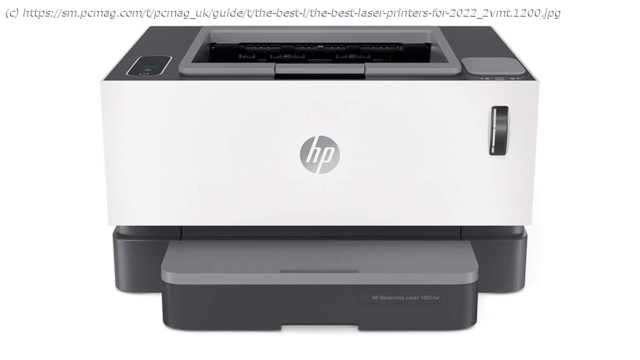Today’s laser printers deliver unparalleled speed, pristine text, and reliable paper handling. Find the best one for your home or office with our shopping tips and list of top-rated, tested models.
When the first laser and inkjet printers meant for PCs became available—at about the same time, in the middle of the 1980s—each was limited to monochrome printing only, and the advantages for each were obvious. Lasers were far faster and delivered much better text quality at a lower cost per page, while inkjets were cheaper to buy. Today, the capabilities for both overlap more, making the advantages for either more nuanced. Some things remain the same, though. Laser printers still offer some obvious strengths: fast print speeds and reasonable costs per page (especially for text output); crisper edges than inkjets, giving a cleaner, more professional look to text and line graphics; more saturated, vibrant color than most inkjets when both are printing on plain paper; resistance to fading; and smudge-proof output. On the downside, lasers are nowhere near as capable as inkjets for producing fine gradients in color graphics and photos. So, who would find a laser printer preferable to an inkjet? Definitely not a home user looking to print photos, much less a photo enthusiast or professional photographer, and not someone looking for a portable printer. But lasers are a good fit for text and graphic output, particularly in bulk: long research papers, book drafts, contracts in law offices, monthly invoices, and the like. And for printing boardroom-quality reports on plain paper, they do much better than inkjets at producing crisp, professional looking text and eye-catching color business graphics. If you print a lot of large jobs, stick mostly to text and graphics, and don’t need high quality for photos, a laser printer is likely the best match. Lasers are also a good choice if high-quality, stable text printing matters most. Indeed, certain types of businesses, such as medical and law offices, may mandate laser printing for archival tasks and record keeping. And although inkjet text output is often close to laser quality at point sizes of 10 or 12 points, most lasers produce much more readable text at small sizes than almost any inkjet. If you need to print at 4 or 6 points, lasers are still the way to go. It can also be cheaper to print marketing materials with photos, including tri-fold brochures or one-page handouts, using a color laser that offers business-quality photo output than to pay for small print jobs at a print shop. Innovations in laser printing in recent years include the refillable toner on the HP Neverstop Laser line. Also consider how often you print. Conventional wisdom says that inkjets are the best choice for home use. But if you don’t print photos, there’s a strong argument for considering a laser for light-duty home use, as well, particularly if you leave your printer off for long stretches. Unlike ink in inkjets, laser-printer toner doesn’t dry out or clog nozzles. Indeed laser printers have no nozzles to clog. Even if you leave a laser printer idle for months, it will print without problems when you turn it on again. Aside from the added convenience, eliminating the cost of wasted ink on nozzle-cleaning routines might save you more than a laser printer’s extra cost compared with a less expensive inkjet. What Kind of Laser Do You Need: Print Only, or AIO? As with any printer technology, lasers can be either single-function or multifunction printers (MFPs), aka all-in-ones (AIOs), which is to say they can be limited to printing only, or they can add scanning at a minimum, usually copying, and often faxing as well. Either type can be a mono-only printer, or can print in color also. In a lot of scenarios, it makes good sense to pick a single-function laser printer rather than spend more money to get what is sometimes the same printer with a scanner added. Consider whether you need heavier-duty scanning (including scans for copying and faxing) than an AIO can handle. If so, you’ll need a separate scanner, anyway, which will likely make the extra functions of an AIO superfluous. Similarly, if you already have another AIO (or a copier and a fax machine), consider whether getting a second AIO will add any convenience or capability. At the other extreme, you may scan so little that you can take care of the occasional capture with a scan app on your phone or just take photos. Unless you need to scan files to PDF format or use optical character recognition (OCR) to turn the scans into text files, you’ll probably be scanning to the same JPG format that photos use, anyway. Printer-only models are available in the entire range from inexpensive monochrome units meant for home-office, micro-office, or student use to floor-standing printers (mono and color) that hold thousands of sheets of paper in multiple paper drawers at once. (The latter are suitable for large workgroups or entire departments.) In between are mono and color models designed for home and micro offices, as well as models for small offices and workgroups. The added functions in laser AIOs are the same as in inkjet AIOs, with the same potential variations. Almost all print, copy, and scan. Many fax, as well, and scan-to-email features are common. The copying, faxing, and emailing can be limited to standalone capability, through the computer only, or both. And so on. (For more variations see The Best All-in-One Printers for 2022.) One common misunderstanding about mono laser AIOs is to think that the scanning they can do is also monochrome only. In truth, with a theoretical exception of some oddball model we haven’t seen, the scanners on any AIO today can scan in color. Compared with inkjet AIOs, the advantages of laser AIOs include higher quality text, most noticeable at small font sizes, and smudge-proof output. Color laser AIOs also offer more vibrant color when printing on plain paper. However, know that although mono laser AIOs can handle schematics and other simple line drawings well, their output quality for graphics otherwise is generally no better than serviceable. Some color inkjet models have a built-in automatic document feeder for easy scanning. Whether single-function or multifunction, the range of monochrome lasers runs from small inexpensive models with modest paper handling suitable for personal desktop printing in any size office, all the way up to multi-thousand-dollar models offering speed, durability, and paper handling meant for high-volume printing in a busy large office. Color lasers add vibrant color graphics. And, as already mentioned, in addition to their high-quality text and graphics, many color lasers can print photos well enough for brochures and other marketing materials, allowing many companies to take such printing in-house. Will a Laser Cost More Than a Comparable Inkjet, or Less? As surprising as it may seem, a laser printer can be less expensive in the long run than a comparable inkjet. You really have to look at the total cost of ownership to figure that out, though.






